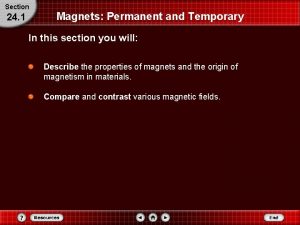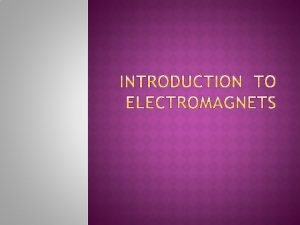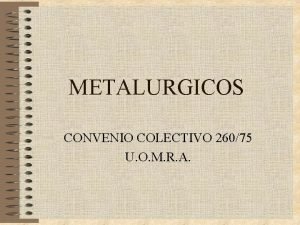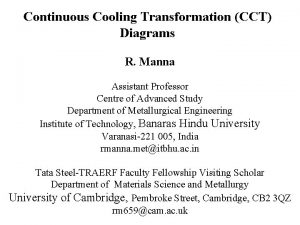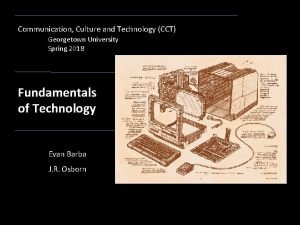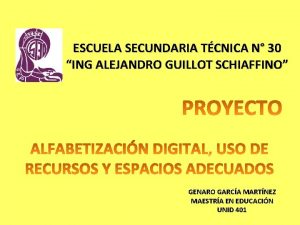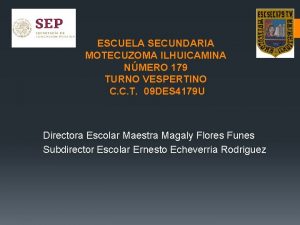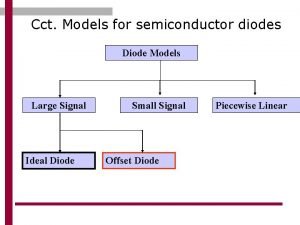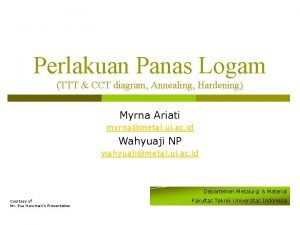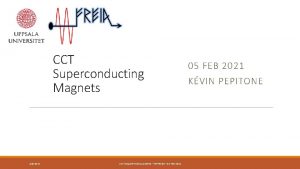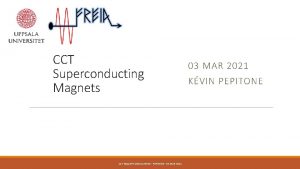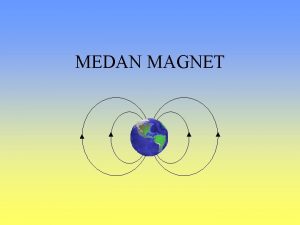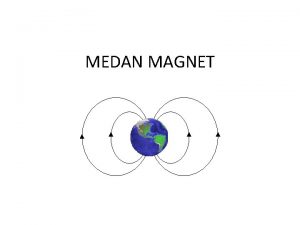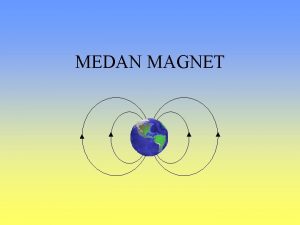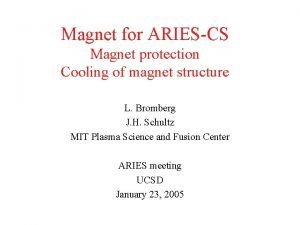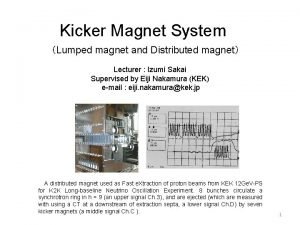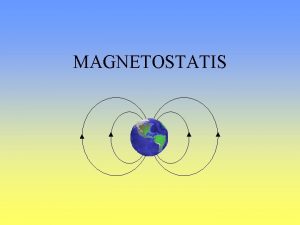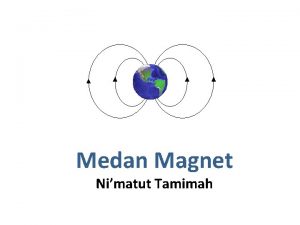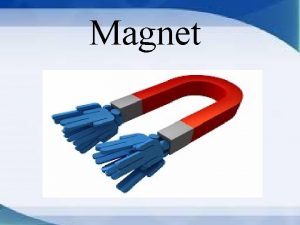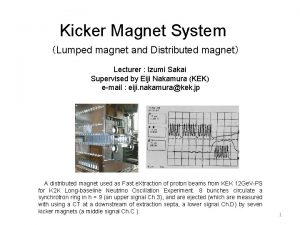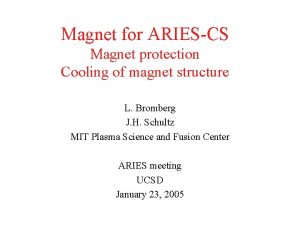Short Sample Limits Magnet Design Limits for CCT

















- Slides: 17

Short Sample Limits / Magnet Design Limits for CCT Coils Ian Pong (ipong@lbl. gov) Workshop on Nb 3 Sn technology for accelerator magnets 11 -12 October 2018 Paris, France 1

Acknowlegement • Lucas Brouwer • Diego Arbelaez • Soren Prestemon Workshop on Nb 3 Sn technology for accelerator magnets 11 -12 October 2018 Paris, France 2

Outline • • Introduction ─ Recalling SSL definition JC as a function of B, T, ε Reversible means no degradation; Degrade implies permanent A visualization technique for application of Ic strain scaling – Combination of Opera 3 D, ANSYS, and strain models – Example of CCT 4 • Summary Workshop on Nb 3 Sn technology for accelerator magnets 11 -12 October 2018 Paris, France 3

Even optimally designed magnet may never achieve SSL • “Short sample limit” is typically the intersection of the “load line” with the B-J(-T) critical surface, where the “load line” is determined as the “highest field” position. • Issues: a poorly designed* magnet may operate very far from SSL. Even optimally designed magnets may never achieve SSL. This ceiling gap is often generically absorbed as “margin”. Workshop on Nb 3 Sn technology for accelerator magnets 11 -12 October 2018 Paris, France 4

Nb 3 Sn JC is a function of B, T, and strain BC 2* (ε, T) [T] • Nb 3 Sn JC is a function of B, T, ε • Formulation may differ: advocate Ekin’s USL with Bordini’s exponential strain function and Bordini’s hybrid 2 temperature scaling. For simplicity, we use here (and recommend) single pinning. ε 0 [%] TC (ε) [K] Workshop on Nb 3 Sn technology for accelerator magnets 11 -12 October 2018 Paris, France 5

Degrade implies permanent • Reversible strain is like reversible field and temperature • Degrade implies permanent N. Cheggour et al. , “Influence of Ti and Ta doping on the irreversible strain limit of ternary Nb 3 Sn RRP wires" Supercond. Sci. Technol. , vol. 23, Art. no. 052002, 2010. Workshop on Nb 3 Sn technology for accelerator magnets 11 -12 October 2018 Paris, France 6

Field Map at ANSYS Nodes Generated using Opera location of conductor mesh nodes build and mesh ANSYS mechanical model of CCT 4 field at conductor (by node) Magnetic and Mechanical Results Courtesy of Lucas Brouwer Workshop on Nb 3 Sn technology for accelerator magnets 11 -12 October 2018 Paris, France 7

Nodal Strain Map Exported from ANSYS Taking into account: - Mechanical preload - Cool down - Energization effects - etc. solve mechanical model in ANSYS build and mesh ANSYS mechanical model of CCT 4 Workshop on Nb 3 Sn technology for accelerator magnets 11 -12 October 2018 Paris, France 8

ANSYS Strain Converted to Cable Coordinate System • ANSYS strains* are converted from global ԑx, ԑy, ԑz, ԑxy, ԑyz, ԑxz to local ԑt, ԑr, ԑb, ԑtr, ԑrb, ԑtb using an element coordinate system aligned with the cable r Local cable frame Ex. broad face - channel interface t Srb Stb t: tangent (along cable) r: radial (along broad face) b: binormal (across cable edge) *With the (possibly large) uncertainty of the proper mechanical properties of the materials used in the analysis Workshop on Nb 3 Sn technology for accelerator magnets 11 -12 October 2018 Paris, France 9

Strain calculation • • assume a residual strain of -0. 2% along the cable direction (t) apply residual strain to local results from ANSYS calculate principal strains and apply strain scaling (matlab) write nodal results to paraview file for viewing on mesh B. Bordini et al. , "An exponential scaling law for the strain dependence of the Nb 3 Sn critical current density, " Supercond. Sci. Technol. , vol. 26, Art. no. 075014, 2013. Workshop on Nb 3 Sn technology for accelerator magnets 11 -12 October 2018 Paris, France 10

Comparison • Using CCT 4 as an example • Short-sample calculation without ANSYS strain (residual strain only) versus with ANSYS strain (Lorentz force + cooldown) • Assumptions: – No degradation due to cabling – Cable modulus = 45 GPa (isotropic) – Strain on cable = strain on Nb 3 Sn filament – Residual strain = 0. 2% Workshop on Nb 3 Sn technology for accelerator magnets 11 -12 October 2018 Paris, France 11

CCT 4 short sample calculation without ANSYS strain • nodal method agrees within 2% of traditional SS calculation • verification of node transfer method and Ic fit before applying ANSYS strain Magnet short-sample of 19. 37 k. A using surface field in Opera Nodal I/IC @ 19. 37 k. A using ANSYS/Opera/matlab scalings Workshop on Nb 3 Sn technology for accelerator magnets 11 -12 October 2018 Paris, France 12

CCT 4 short sample calculation with ANSYS strain • Requires iteration: IC curve is now a moving target since ε is also a function of B and I • Scale ε and B as function of I until a part of the magnet has I/IC = 100% 17. 83 k. A, short-sample also including ANSYS strain In theory this correlates to temperature margin Workshop on Nb 3 Sn technology for accelerator magnets 11 -12 October 2018 Paris, France 13

Comparison of results from previous slides • Including strain lowers the magnet short-sample limit by 1. 5 k. A and also changes the distribution of margin in the magnet • “hotspot” is much more localized when strain map is considered 19. 37 k. A, short-sample with residual strain only 17. 83 k. A, short-sample also including ANSYS strain I/IC (%) Workshop on Nb 3 Sn technology for accelerator magnets 11 -12 October 2018 Paris, France I/IC (%) 14

Motivation for This Type of Analysis • Identification of potential trouble spots within the magnet (hotspots when both field and strain are considered) • guide test diagnostic placement • guide mechanical design changes to reduce or eliminate trouble areas • Some understanding (with large assumptions) of the impact of strain on magnet short-sample limits • Ex: CCT 4 peak current was 16. 73 k. A (86% of ITER barrel measured SS, 94% of SS with strain) Workshop on Nb 3 Sn technology for accelerator magnets 11 -12 October 2018 Paris, France 15

Caveats • Strain depressed results are only as accurate as both the strain dependency model and the finite element results – origin and accuracy of strain dependency models in 3 D – strain at micro scale can be different than macro scale – many assumptions in CCT 4 ANSYS model (no delamination, cracking, etc. ) • This study is not connected to disturbance spectrum in magnet, but training behavior is – danger of over correlating strain suppressed Ic to magnet training Workshop on Nb 3 Sn technology for accelerator magnets 11 -12 October 2018 Paris, France 16

Summary • ITER barrel short sample is still standard: SSL • Nb 3 Sn JC is a function of B, T, ε • The combination of mechanical, magnetic, and strain dependency models can be used to study local Ic with strain included – still many unknowns and limitations of these models, which require strong assumptions – but, this is a valuable technique in that it gives insight into potential trouble spots within the magnet and some understanding of a strain suppressed short-sample limit Workshop on Nb 3 Sn technology for accelerator magnets 11 -12 October 2018 Paris, France 17
 Short short short long long long short short short
Short short short long long long short short short What happens when you break a magnet in half
What happens when you break a magnet in half Permanent and temporary magnet
Permanent and temporary magnet Kata “magnet” diduga berasal dari kata …
Kata “magnet” diduga berasal dari kata … Lim as x approaches infinity
Lim as x approaches infinity Shape 65
Shape 65 Qualiroute
Qualiroute Uomr
Uomr Qualiroutes
Qualiroutes Slope change in a cct diagram signify
Slope change in a cct diagram signify Cct theory
Cct theory Georgetown university cct
Georgetown university cct Cct 104
Cct 104 Cct secundaria tecnica 30 alejandro guillot schiaffino
Cct secundaria tecnica 30 alejandro guillot schiaffino Secundaria 179
Secundaria 179 Sec 214
Sec 214 Offset diode model
Offset diode model Diagram ttt
Diagram ttt

